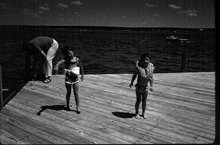
H.C. Pipkin, Winter Cedars, Palo Duro, 1947
“Even the most perfect reproduction of a work of art is lacking one element: its presence in time and space, its unique existence at the place where it happens to be…the authenticity of a thing is the essence of all that is transmissible from its beginning, ranging from its substantive duration to its testimony to the history which it has experienced.”
--Benjamin, “The Work of Art in the Age of Mechanical Reproduction”
I don’t remember when the idea occurred to me to reprint my grandfather’s negatives. I spent long hours down in the cellar up to my elbows in dust, reading letters he wrote to my grandmother in the war, trying to figure out the meaning of excised words. When had he stopped speaking to us? When we were much younger he taught us to play chess, told us stories, let us fashion animals out of his pipe cleaners. As I grew older he rarely left his room. My grandmother nailed a sign to his door that said, “Please don’t feed the animals.” We didn't. It stayed on the door long after he died.
His soul died, I think, long before his body did. Of what? Dreams unfulfilled? Some secret pain? Did my grandmother know the source of his longing? Did anyone? His life is like those war letters, all the critical words removed so that no one could ascertain what was truly important--his location in this world, his orientation, what he had truly meant to say.
Annie Dillard wrote, “We are here to witness.” Watching the emerging images of a sixty-year old negative I feel the responsibility of the witness, but have no idea what it is I am witnessing. Perhaps just the act of bearing the burden of these rotting boxes of fragile images--some “unique existence at the place where it happens to be” is all that is asked of me. Just to see.



